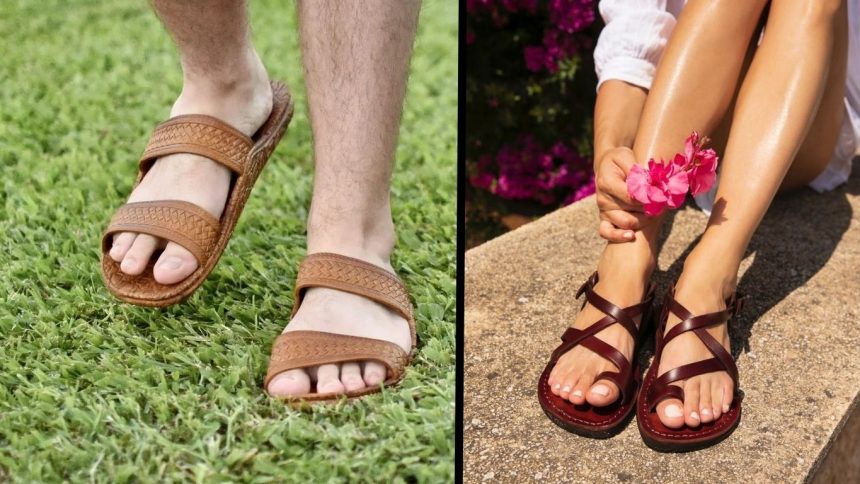When you think about sandals that have stood the test of time, Jesus sandals immediately come to mind. Simple, functional, and deeply symbolic, these sandals have moved from ancient practicality to modern-day fashion. But why do these sandals remain so iconic after thousands of years? Let’s take a closer look at their history, meaning, styles, and modern relevance.
The Origins of Jesus Sandals
Sandals are among the earliest footwear invented by humans. In ancient times, they weren’t just a style statement—they were survival tools. Crafted from leather, plant fibers, and other natural materials, sandals kept feet cool in hot climates while offering some protection against rough ground.
The sandals commonly linked to Jesus were basic leather straps tied across the foot with a sole made of animal hide. This minimal design was practical in the dusty, rugged terrain of the Middle East. They weren’t luxurious, but they did the job effectively.
Why Are They Called Jesus Sandals?
The name comes from depictions of Jesus in religious art, movies, and illustrations. Almost every image shows him wearing simple brown leather sandals. Since footwear of that style was common during biblical times, it became symbolic. Over time, this humble design earned the nickname “Jesus sandals.”
Interestingly, these sandals have also been called Jerusalem cruisers, biblical sandals, or even hippie sandals in pop culture, showing how they transcend cultures and generations.
Symbolism Beyond Footwear
Jesus sandals are not just leather soles and straps. They symbolize humility, simplicity, and grounding. In many cultures, shoes reflect wealth or status. But sandals like these reject excess, reminding wearers of a life focused on essentials rather than extravagance.
Some also view them as spiritual footwear, representing the journey of life, faith, and resilience. Walking in such sandals is often described as walking closer to the earth—a literal reminder of being grounded.
The Design: Simple Yet Practical
At first glance, Jesus sandals may look plain. But their design is clever:
-
Straps for security – The crisscross straps keep the sandal in place, even on uneven terrain.
-
Open-toed comfort – Perfect for hot weather, they allow the feet to breathe.
-
Durable soles – Traditionally made from thick leather, they could withstand long journeys.
This balance of comfort, strength, and ventilation made them ideal for desert landscapes and long treks. Modern versions often replicate this design but with updated materials like rubber soles for extra cushioning.
From Ancient Times to Modern Fashion
How did a sandal worn 2,000 years ago become a fashion trend today? The answer lies in their adaptability.
In the 1960s and 70s, the counterculture movement embraced Jesus sandals as a symbol of freedom and rebellion against materialism. Hippies wore them to show a return to nature and simplicity. Since then, they’ve appeared on runways, in everyday wear, and even as luxury items sold by big brands.
Today, you’ll find versions made by companies like Birkenstock, Teva, and smaller artisan brands. Some stick closely to the biblical design, while others modernize them with arch support, cushioned soles, or vegan leather alternatives.
Cultural Impact Across the Globe
Jesus sandals aren’t limited to religious associations. Around the world, similar styles appear under different names:
-
Israel – Known as “biblical sandals,” they are popular with locals and tourists alike.
-
India – The kolhapuri chappal shares similarities in its handmade leather style.
-
Mexico – Huaraches, woven leather sandals, carry the same earthy, practical essence.
This cross-cultural presence proves the universality of simple design. Wherever you go, the concept of open, strappy sandals remains timeless.
Why People Still Love Them Today
So, what keeps Jesus sandals popular in modern times?
-
Comfort – They’re lightweight and easy to wear for long periods.
-
Breathability – No sweaty feet in summer heat.
-
Versatility – They pair well with casual outfits, beachwear, or even semi-formal looks.
-
Symbolism – Many wear them to represent values like humility and simplicity.
-
Durability – Leather sandals, if cared for, can last years.
It’s rare for a piece of footwear to combine practicality, symbolism, and fashion appeal so seamlessly.
Styling Jesus Sandals in Modern Fashion
You might wonder, “How do I wear Jesus sandals without looking like I stepped out of a history book?” The truth is, they’re surprisingly versatile.
-
Casual look – Pair with shorts and a linen shirt for a relaxed summer vibe.
-
Bohemian style – Flowing skirts, loose tops, and earthy jewelry complement their natural look.
-
Urban outfit – Match them with jeans and a fitted tee for a minimalist touch.
-
Beachwear – Perfect for vacations, easy to slip on and off.
Think of Jesus sandals like jeans—they never really go out of style, just adapt with the times.
Handmade Craftsmanship
Many Jesus sandals are still made by hand, especially in places like Jerusalem and Bethlehem. Artisans use techniques passed down for generations, cutting and stitching the leather with care.
This makes each pair unique. Unlike mass-produced shoes, handcrafted sandals carry a personal touch, almost like wearing a piece of history. Supporting such craftsmanship also helps preserve cultural traditions.
Care and Maintenance
If you own a pair, taking care of them ensures they last longer. Here are a few simple tips:
-
Clean with a damp cloth to remove dirt and dust.
-
Avoid soaking in water, as it can damage leather.
-
Use leather conditioner to keep the straps supple.
-
Store in a cool, dry place when not in use.
Proper care turns a simple pair of sandals into a long-lasting wardrobe staple.
Jesus Sandals as a Metaphor
Beyond fashion, Jesus sandals often serve as a metaphor. To “walk in someone’s sandals” means to see life from their perspective. In this way, these sandals represent empathy, connection, and shared humanity.
Just like how stepping barefoot on sand instantly grounds you, wearing these sandals can feel like stepping closer to the basics of life—free from unnecessary weight.
The Future of Jesus Sandals
Looking ahead, these sandals aren’t going anywhere. With rising interest in sustainable fashion, simple leather sandals fit perfectly into the eco-conscious movement. Many brands are now making them from recycled materials or vegan leather.
Their design is proof that less is more. Instead of chasing fast fashion, people are rediscovering timeless pieces that last and carry meaning. Jesus sandals, in this sense, are not just old—they are forever modern.
Conclusion
From the dusty roads of ancient Jerusalem to the fashion streets of today, Jesus sandals have walked a long journey—literally and metaphorically. They carry with them not only the weight of history but also the lightness of simplicity. Whether you wear them for comfort, symbolism, or style, these sandals remind us that sometimes, the simplest things endure the longest.
FAQs
What are Jesus sandals made of?
Traditionally, they were made from animal hide, leather straps, and simple stitching. Modern versions may include rubber soles, synthetic materials, or vegan leather alternatives.
Are Jesus sandals comfortable for everyday wear?
Yes, they are lightweight and breathable, making them ideal for warm weather and casual use. Some modern versions add arch support for extra comfort.
Can Jesus sandals be worn with formal clothes?
While they are mostly casual, minimalist designs in darker shades can pair well with semi-formal summer outfits.
How do I care for leather Jesus sandals?
Wipe them clean with a damp cloth, condition the leather regularly, and avoid soaking them in water to prevent damage.
Why are Jesus sandals still popular today?
Their enduring appeal comes from their comfort, simplicity, symbolic meaning, and ability to adapt to both cultural and fashion trends.









